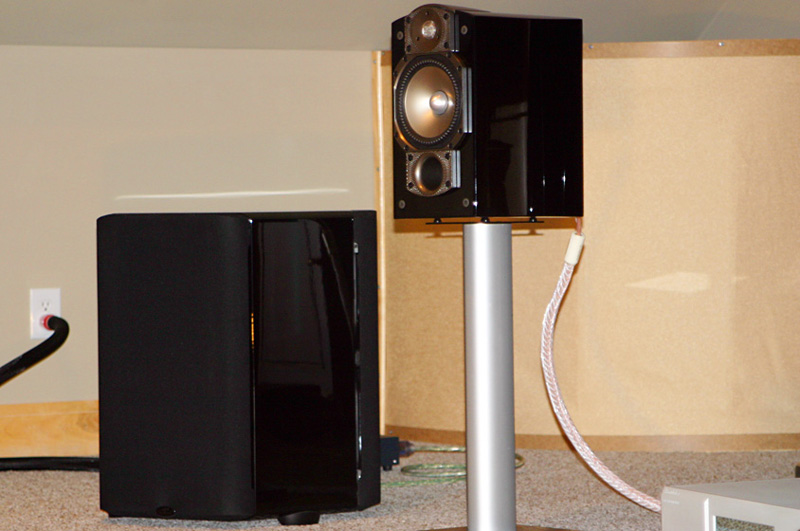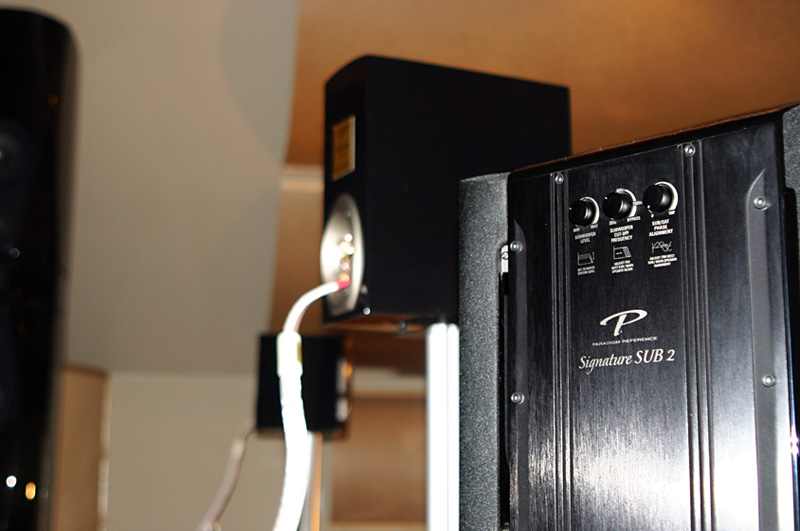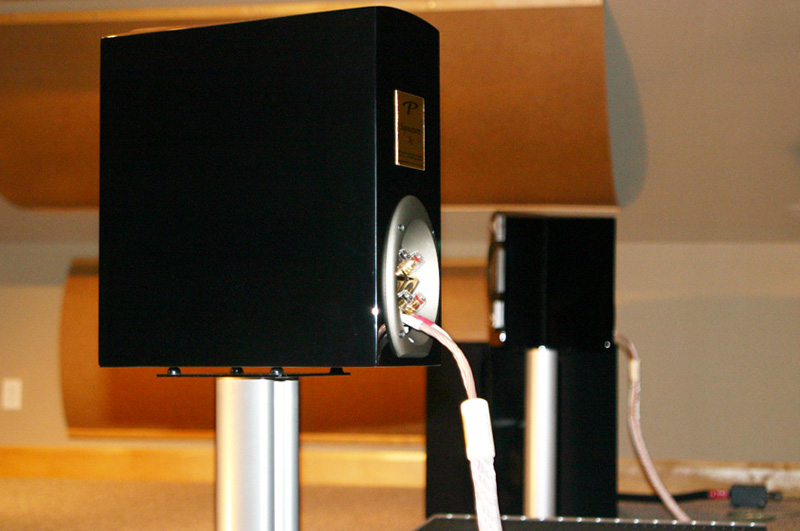| March 1, 2010


|
TWBAS 3/2010
Speakers: Rockport Technologies Arrakis,
Dynaudio Focus 360
Amplifiers: Boulder Amplifiers 2060,
Classé Audio Omega Omicron Monos
Preamplifiers: Simaudio Moon Evolution
P-8, Boulder 1010
Sources: Apple MacBook running iTunes and
Amarra, Bel Canto DAC3VB/VBS1, Simaudio Moon Evolution 750D DAC/transport
Cables and power conditioning: Shunyata
Research: Aurora-IC interconnects, Aurora-SP speaker cables, Hydra V-Ray II power
conditioner; Anaconda Helix Alpha/VX, Python Helix Alpha/VX, Taipan Helix Alpha/VX power
cords |
|
|
How Close Can I Get for Half
the Price or Less? -- Paradigm Reference Signature S2 v.3 Loudspeakers
In high-end audio, the ratio of price to performance is
often a sticky subject. Audiophiles seem to generally agree that, as the price increases,
returns diminish. In other words, the degree of improvement in performance does not
increase linearly with the degree of increase in cost. When you spend, say, twice as much
money for a set of loudspeakers than you would for a different set, you don’t get
sound that is, subjectively, twice as good. Other than the love-struck owner of a shiny,
new, expensive gizmo who’s trying to justify that purchase, you’ll find few who
will disagree.
The sticky part is whether the more expensive gear is
always better, to however small a degree, simply because it’s more expensive.
The old adage "You get what you pay for" should apply to high-end audio,
but sometimes it doesn’t. Sometimes, you get more performance than you thought was
possible by spending less money more wisely.
Can you imagine your audio buddy’s shock when you tell
him that you’ve just bought a set of speakers that are better than his, for half what
he paid? He might not believe you, and even if you demonstrate the superiority of your new
purchase, he might not want to admit it. But it could happen. Here’s how.
Paradigm
It’s no secret that Paradigm is a progressive maker of
loudspeakers and electronics that have been popular among SoundStage! Network writers for
many years. I visited the company in September, during The
Great North American Loudspeaker Tour. I was impressed to see more engineers than I
could count on two hands busily performing tasks that would no doubt lead to products sure
to perform well. They ably demonstrated this to me while I was there. Paradigm is an
engineering-driven company that scientifically designs and tests its products, eschewing
the shot-in-the-dark philosophy of design of many lesser firms that sometimes make more
expensive audio gear.
The Reference Signature S2 v.3 loudspeaker is a good
example of what Paradigm can offer for $2598 USD per pair. Flash back to the 2010 Consumer
Electronics Show: In my SoundStage! Network article "Mainstream Beryllium," I discussed the use in speakers of that
element, which is light but dangerously toxic to work with. Many designers feel that
beryllium’s extreme hardness and stiffness make it an ideal metal to make tweeter
diaphragms from. A dome tweeter made of beryllium doesn’t "break up," or
lose its shape and become nonpistonic, until it’s reproducing frequencies far above
the upper limit of human hearing (generally regarded as 20kHz). Because a beryllium
dome’s behavior remains linear to somewhere around 40kHz, what you hear up to 20kHz
will be more accurate. Whereas beryllium-dome tweeters can be found in much more expensive
speakers, Paradigm manages to offer their Signature models with 1" P-BE tweeters at
prices that many audiophiles can afford (P-BE = pure beryllium). The P-BE tweeter in the
S2 v.3 hands off to the bass/midrange driver at 1.8kHz via a crossover with a third-order
slope.
That P-BE tweeter isn’t the only trick up the S2
v.3’s sleeve -- there’s a lot of advanced thinking packed into this small
two-way, stand-mounted speaker, which measures only 15"H x 8.25"W x 14"D
and weighs 28 pounds. The 7" Co-Pal (cobalt-infused pure aluminum) bass/midrange
driver has what Paradigm calls a Non-Limiting Corrugated surround. This allows the S2 v.3
to play louder and more linearly than the S2 v.2 because the cone can travel farther
before its motion is impeded by the surround. The bottom line is that Paradigm has
optimized the drivers in the S2 v.3 for the clean, loud, and linear reproduction of sound.
When you have the resources of a Paradigm, in terms of both technical talent and
manufacturing efficiency and capability, you have some strong advantages. The drivers in
the S2 v.3, it seems to me, would be right at home in products costing many times as much.
The Reference Signature S2 v.3 is claimed to have a
frequency response of 52Hz-45kHz on axis, and an anechoic sensitivity of 88dB. But this is
"The World’s Best Audio System" -- I’m after a lot more than merely
good -- or even excellent -- performance from a stand-mounted speaker. To be even
considered as a contender for the state of the art, a system must be full-range, which
means low bass. So I paired the S2 v.3 with Paradigm’s best subwoofer, the
Reference Signature Sub 2. I reviewed this model on SoundStage! back in October of 2009
and found it to be among the best subwoofers available at any price. In fact, I concluded
that the Sub 2 is "a tremendously ambitious effort that redefines what should be
expected of a powered subwoofer. I haven’t experienced another subwoofer that I think
is as capable, and certainly not when considering the price." In terms of
nuts’n’bolts, the Sub 2 has all the right stuff: a hexagonal sealed cabinet that
measures 24.3"H x 22.9"W x 21.1"D and weighs 289 pounds; six high-excursion
10" drivers, two on each of three sides; and Paradigm’s Ultra-Class-D amplifier,
which puts out 7500W peak or 3000W sustained (from a 120V line). The Sub 2 retails for
$7499, including the Perfect Bass Kit PBK-1 -- Paradigm’s proprietary room-correction
system, designed to smooth bass irregularities within the subwoofer’s operating range
that are caused by room modes.

Setup is key
You can’t get state-of-the-art sound in a room with
compromised acoustics. As much as I love technologies such as Paradigm’s PBK-1 (the
room-correction program derived from sister company Anthem’s ARC system), or the
systems from Audyssey, Behold, and other companies, these are not the preferred
method for addressing room acoustics. Such software packages are mainly intended to be
used with rooms that haven’t been designed and furnished with good acoustics in mind.
That includes the vast majority of rooms that stereo equipment will end up in, including
the rooms of most reviewers. My room isn’t perfect, either, but it’s close
enough to acoustic neutrality to obviate the need for room correction: The Music Vault
provides the type of acoustic environment in which linear speaker systems really like to
operate.
I went about setting up the Reference Signature S2 v.3 and
Sub 2 just as I would any other system: I listened, measured, tweaked, listened again,
rearranged, fine-tuned, listened some more . . . until I finally got the melding
of the speaker and sub outputs as close to perfect as I could. (I described this process
in detail in "Integrating Super Subwoofers
into an Ultra System." If you’ve read that article, the one obvious
deficiency you’ll spot right away is that I’d have been better off with two
Sub 2s. I discuss some alternatives below.)

The sound of SOTA
"How close can I get for half the price or less?"
Pretty. Darn. Close. At least in some areas. The Reference
Signature S2 v.3 could compete in the highs with virtually anything I’ve heard at any
price. It was neutral and extended, clean and precise, without being harsh or brittle. And
I threw some hard tests at it: Reference Recordings HRx discs, hi-rez recordings on
Blu-ray and downloaded from 2L Records, and my best "Red Book" CD recordings, as
served up by my computer. The S2 portrayed the detail in those recordings, specifically in
the highs, with an extra dose of precision and supremely textured detail. The extension
did seem limitless up top -- the beryllium tweeter delivered on its promises -- and that
detail made me want to just sit back and revel in the smooth, fine overwash of musicality
that defined its sound.
The orchestral strings in Marianne Thorsen’s recording
of the Allegro of Mozart’s Violin Concerto No.4, K.218, with Řyvind Gimse and
the Trondheimsolistene, from the 2L sampler The Nordic Sound (BD/SACD, 2L
2L-RR1-SABD; Thorsen’s recordings of Concertos 3-5 are available on 2L 2L38SACD),
were sweetly refined, precisely textured and focused, and extended to the very top of what
I could hear without ever making me fatigued. Thorsen’s violin floated freely between
the speakers, placed squarely in the center of a wide, deep soundstage. The sound was so
clearly detached from the speaker cabinets that one visitor to my room simply could not
believe the sound was coming from the little S2 v.3s -- until he got up from his
seat, walked over to the speakers, and checked it out for himself. "Amazing!"
was all he said. This track, played back at 24-bit/192kHz resolution, is a real test for
any tweeter, as well as for how well the highs integrate with the output of the midrange
driver. This is where expert crossover design comes in, and here the S2 v.3 shone.
The next track on the 2L sampler is an even better example
of a seamless transition from highs to mids: the Dena Piano Duo performing, with great
dexterity and verve, the Allegro molto of Mozart’s Sonata for Two Pianos in D,
K.448. (The complete recording is available on the duo’s second collection of works
by Mozart and Grieg, 2L 2L57SABD.) The little two-way Paradigm was up to the challenge,
making the handoff of tweeter to midrange seamless and inaudible. The combination of
crystal-clear upper midrange and focused, precise soundstaging made these speakers a
simple joy to listen to.
The bass was everything I said it was in my review of the
Sub 2. Bass quantity will simply never be an issue. If you maintain flat frequency
response in your room, I do think the S2 v.3s will be more susceptible to compression and,
ultimately, damage, before the Sub 2 will -- you’ll run out of headroom in the mids
and highs before you hit the limits in the bass. But these days, it’s cheap and easy
to deliver large quantities of bass; in a TWBAS system, it’s quality
we’re after.
In two words: Quality delivered. The Sub 2 sounded
effortless. None of its parts -- box, drivers, amplifier -- seemed to strain to produce a
sound with an ease that I found fascinating. In my review, I stated, "With more
subtle music, but an album whose bass is just as dramatic [as on Audioslave’s
eponymous album] -- Patricia Barber’s Café Blue (CD, Premonition 737) -- the
Sub 2 seemed to feel just as at home. ‘Nardis’ features a drum solo that starts
about 5:30 into the track. Mark Walker’s kickdrum is much more subdued than that on
[Audioslave’s ‘Show Me How to Live’] -- more damped, and even tighter in
delivery. But if it isn’t reproduced with good articulation and agility, it can start
to sound mushy, woolly, or just plain weak. The Sub 2 was quick enough to reproduce the
drum perfectly, and deft enough that it never fell behind the rest of the music, or
sounded loose."
Sounding as if it’s "keeping up" with the
music is not only about a subwoofer’s inherent quality -- though clearly it’s a
great part of that quality. It has just as much to do with the interaction of the sub with
the room, and with the satellites’ reproduction of the leading edges of
upper-register harmonics. In short, to suspend the listener’s disbelief that he is
hearing live music in his home, the integration of the room with the outputs of the
satellites and subwoofer is paramount.
I couldn’t hear the transition point between the Sub 2
and the S2 v.3s -- a very good thing. But I did hear a shortcoming: With the Paradigm
Reference combo, I was never able to get the level of articulation in the low and midbass,
and the pure midbass precision, that I’ve heard from the best and largest speaker
systems. Perhaps this was because the best systems I’ve heard have been four-way
designs; perhaps it was the fact that a speaker system designed to be full-range to begin
with, and listened to in an acoustic environment as neutral as the Music Vault, has an
inherent advantage over one that the user has to optimize by adding a subwoofer. Or maybe
it was a function of more money being spent on the design and construction of those larger
systems’ crossovers, cabinets, or something else. These are the areas -- and it
extended up into the lower midrange, where I’ve heard even finer textures from some
more expensive systems -- in which the Paradigm combo fell ever so slightly short of
the very best I’ve heard. But I’m speaking of the best speakers I’ve
ever heard; designs that cost many multiples of the Paradigm combo’s total price of
$10,097.

Alternatives and where it all shakes out
Perhaps a better alternative to the Sub 2 would be a pair
of Paradigm Reference Sub 1s, at $3499 each, for a total of $6998 ($501 less than a single
Sub 2). The Sub 1 is similar to the Sub 2, but with six 8" instead of six 10"
bass drivers. This would perhaps let you get even smoother, better-integrated bass than
you would with a single sub. If your budget allowed, you could buy a pair of Sub 2s, but
that would throw this experiment into a whole ’nother price class.
But while we’re talking increased price: If you could
stretch your budget and get the S6 v.3 ($5198/pair), a three-way model that sits right
above the S2 v.3, you could cross over the sub(s) at an even lower frequency -- which
would very likely be an advantage. (With the S2 v.3s running full-range, I crossed over
the single Sub 2 at 70Hz.) You’d have to hear the S6, though, to determine if
you’d lose some of the S2’s unquestionable minimonitor appeal. The point here is
that a Sub 2 and a pair of S2 v.3s isn’t the only way to get into a system as good as
this. You could spend more. You could also cut a few grand off the proposition I’ve
detailed in this article by getting a single Sub 1 and a pair of S2s -- that would be a
system to beat for a good bit less than $6500.
There’s no doubt that a system like the Paradigm
Reference Signature S2 v.3 and Sub 2 can compete with many speakers costing twice or
thrice as much -- or more. It will have the frequency extension in both the highs and the
lows to match any of them. It also can make magic between those frequency extremes
that will compete with almost all, and destroy many, speakers with price tags dearer than
ten grand. In fact, around the Paradigm’s price range, I don’t know of a better
alternative. The best speakers I’ve reviewed that compete price-wise, such as Thiel’s CS2.4SE,
just don’t have the ability to reproduce large-scale music with the sheer oomph
of this Paradigm pairing. Even speakers with such excellent pedigrees as the Wilson Audio Specialties WATT/Puppy 8 and the YG Acoustics Kipod, both of which I’ve
very positively reviewed, don’t play as low’n’loud as the Paradigm combo,
nor do they outpace the S2 v.3s in the super-high frequencies. The Paradigms compete
commendably with products that they would not usually be compared with in a retail store.
There are systems that cost a lot more money than the
Paradigm combo discussed here that surpass it in very important ways. I hear a great deal
more midrange texture, bass articulation, and midbass precision, and more seamless
frequency transitions -- particularly from the mids down -- from speakers such as the Rockport Technologies Altair and Arrakis. The Magico M6 and TAD
Reference One seem to do all the right things that the Paradigm combo does, but more of
it, and even better. Just don’t assume that because a speaker system costs
more, it will automatically be better than the S2 v.3 plus Sub 2. The other speakers
I’ve just listed trounce most of the competition around them.
Ultimately . . .
There is a great alternative for audiophiles who don’t
want to compromise on performance, but who also don’t want to spend a ridiculous
amount of money. The Paradigm Reference Signature S2 v.3 and Reference Signature Sub 2 are
one way to soar into the stratosphere while keeping your budget firmly grounded. Now you
know.
. . . Jeff Fritz
jeff@ultraaudio.com
|